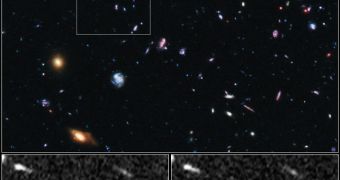The NASA Hubble Space Telescope's Wide Field Camera 3 (WFC3), which was outfitted to the satellite in 2009, was recently able to observe the oldest-known instance of a massive stellar explosion, a Type Ia supernova that blew up more than 9 billion light-years away.
What this means is that the event took place when the Universe was not even 5 billion years old itself. The light this explosion released is only now reaching Earth, after it traveled for a very long time, and was subjected to an intense redshift effect.
Astrophysicists believe that analyzing this supernova – known informally as SN Primo – could lead to a better understanding of the way in which dark energy acts on the Universe. The force is believed to be responsible for the way the largest structures in space interact.
Experts say that the progenitor star for SN Primo was most likely a shrunken, super-dense white dwarf, probably located in a binary system. In these systems, a white dwarf usually accretes mass from its companion, until the influx of material makes it unstable, and eventually blows it up.
This particular type of thermonuclear explosion is very useful for astronomers because it emits light in a very narrow and constant range. This is why Type Ia supernovae are known as “standard candles,” and represent the most stable points of reference when measuring distances in space.
Another interesting use for this type of light is measuring how its properties are affected by the constant expansion of the Universe. Considering that this phenomenon is fueled by dark energy, it's easy to see how supernova light can give insights on the way the Cosmos works.
“In our search for supernovae, we had gone as far as we could go in optical light. But it's only the beginning of what we can do in infrared light,” says principal study investigator Adam Riess.
The expert holds joint appointments at the Space Telescope Science Institute (STScI), in Baltimore, and the Johns Hopkins University (JHU), Space reports. He and his team used data from the CANDELS+CLASH Supernova Project to conduct this investigation.
“This discovery demonstrates that we can use the Wide Field Camera 3 to search for supernovae in the distant Universe,” Riess explains.
Interestingly, if the team fails to find any supernovae that are farther away than SN Primo, then the main implication of this would be that it takes a very long time for a star to reach that stage in its life when it can blow up into a Type Ia supernova.
Details of the new work were presented on January 11 in Austin, Texas, at the 219th annual meeting of the American Astronomical Society (AAS2012). Reiss is one of three physicists who won that 2011 Noble Prize in Physics for discovering dark energy through the use of Type Ia supernovae.

 14 DAY TRIAL //
14 DAY TRIAL //